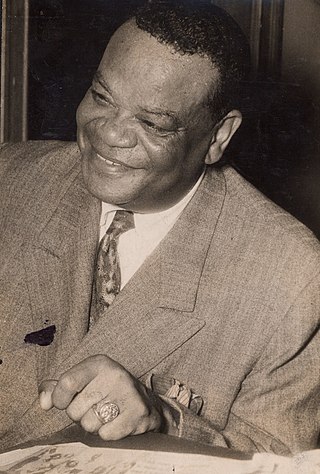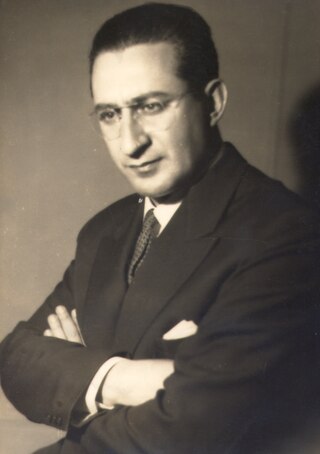Related Research Articles

Heitor Villa-Lobos was a Brazilian composer, conductor, cellist, and classical guitarist described as "the single most significant creative figure in 20th-century Brazilian art music". Villa-Lobos has become the best-known South American composer of all time. A prolific composer, he wrote numerous orchestral, chamber, instrumental and vocal works, totaling over 2,000 works by his death in 1959. His music was influenced by both Brazilian folk music and stylistic elements from the European classical tradition, as exemplified by his Bachianas Brasileiras and his Chôros. His Etudes for classical guitar (1929) were dedicated to Andrés Segovia, while his 5 Preludes (1940) were dedicated to his spouse Arminda Neves d'Almeida, a.k.a. "Mindinha". Both are important works in the classical guitar repertory.

The music of Brazil encompasses various regional musical styles influenced by European, American, African and Amerindian forms. Brazilian music developed some unique and original styles such as forró, repente, coco de roda, axé, sertanejo, samba, bossa nova, MPB, música nativista, pagode, tropicália, choro, maracatu, embolada, frevo, brega, modinha and Brazilian versions of foreign musical styles, such as rock, pop music, soul, hip-hop, disco music, country music, ambient, industrial and psychedelic music, rap, classical music, fado, and gospel.

Choro, also popularly called chorinho, is an instrumental Brazilian popular music genre which originated in 19th century Rio de Janeiro. Despite its name, the music often has a fast and happy rhythm. It is characterized by virtuosity, improvisation and subtle modulations, and is full of syncopation and counterpoint. Choro is considered the first characteristically Brazilian genre of urban popular music. The serenaders who play choros are known as chorões.
Baião is a Northeastern Brazilian music genre and dance style based on a syncopated duple meter rhythm, based around the pulse of the zabumba, a flat, double-headed bass drum played with a mallet in one hand and a stick in the other, each striking the opposite head of the drum for alternating high and low notes, frequently accompanied by an accordion and a triangle pattern. The baião rhythm is integral to the genres of forró, repente and coco. It is mostly associated with the state of Pernambuco. Baião was popularized via radio in the 1940s, reaching peak popularity in the 1950s.

Alfredo da Rocha Viana Filho, known as Pixinguinha was a Brazilian composer, arranger, flautist and saxophonist born in Rio de Janeiro. Pixinguinha composed popular music, particularly within the genre of music known as choro.

Los Hermanos is a rock band from Rio de Janeiro, Brazil. The group was formed in 1997 by Marcelo Camelo (vocals/guitar), Rodrigo Amarante (guitar/vocals), Rodrigo Barba (drums), and Bruno Medina. Currently they are on an extended hiatus, performing some concerts sporadically.

Mozart Camargo Guarnieri was a Brazilian composer.

Joaquim Antônio da Silva Calado, Jr. was a Brazilian composer and flautist.
The Arrocha is a music/dance style that originated in the interior of Bahia, one of Brazil's states, most notably in the city of Candeias.
Chôros is the title of a series of compositions by the Brazilian composer Heitor Villa-Lobos, composed between 1920 and 1929.
Altamiro Carrilho was a Brazilian musician and composer. He is widely regarded as a master flutist and a major representative of the choro genre.
Ilza Nogueira is a Brazilian composer, music educator and musicologist with specialty in the area of music analysis.

Chôros No. 2 is a duet for flute and clarinet written in 1924 by the Brazilian composer Heitor Villa-Lobos. It is part of a series of fourteen numbered compositions collectively titled Chôros, ranging from solos for guitar and for piano up to works scored for soloist or chorus with orchestra or multiple orchestras. and in duration up to over an hour. Chôros No. 2 is the shortest in the series, a performance lasting only about two-and-a-half minutes.

Chôros No. 7, subtitled "Settimino" (Septet), is an instrumental septet written in 1924 by the Brazilian composer Heitor Villa-Lobos. It is part of a series of fourteen numbered compositions collectively titled Chôros, ranging from solos for guitar and for piano up to works scored for soloist or chorus with orchestra or multiple orchestras, and in duration up to over an hour. Chôros No. 7 is of modest length, a performance lasting about eight-and-a-half minutes.

Chôros No. 6 is an orchestral work written between 1925 and 1942 by the Brazilian composer Heitor Villa-Lobos. It is part of a series of fourteen numbered compositions collectively titled Chôros, ranging from solos for guitar and for piano up to works scored for soloist or chorus with orchestra or multiple orchestras, and in duration up to over an hour. Chôros No. 6 is one of the longer compositions in the series, lasting about 25 minutes in performance.

Chôros No. 8 is a work for orchestra and two pianos, written in 1925 by the Brazilian composer Heitor Villa-Lobos. It is part of a series of fourteen numbered compositions collectively titled Chôros, ranging from solos for guitar and for piano up to works scored for soloist or chorus with orchestra or multiple orchestras, and in duration up to over an hour. A recording of Chôros No. 8 conducted by the composer lasts 22 minutes.

Introdução aos Chôros: Abertura, is a composition for guitar and orchestra by the Brazilian composer Heitor Villa-Lobos, composed in 1929 as an overture to precede a complete performance of his series of fourteen Chôros. A performance of just the Introdução lasts about thirteen minutes.

The Quinteto is a chamber-music composition by the Brazilian composer Heitor Villa-Lobos, written in 1928. Originally scored for five woodwind instruments, it is most often performed in an arrangement for the conventional wind quintet of flute, oboe, clarinet, horn, and bassoon. A performance lasts about eleven minutes.
Luiz Americano was a Brazilian choro musician and composer. He was best known as a clarinetist, saxophonist and recording artiste.
References
- 1 2 3 Matos, Marcelo; Lemos, Cristina. "Using the approach of local productive arrangements and systems for the analysis of creative industries in Brazil" (PDF). Academia.edu. Retrieved 20 August 2023.
- ↑ Magalhães Pinto, Marcelo G.M. "The Musical Thought of Egberto Gismonti in 7anéis for Piano" (PDF). FMCB. Retrieved 20 August 2023.
- ↑ Mitchell II, Ceylon. "Selected Flute Traditions in the Americas: Brazilian Chôro, Cuban Charanga, and Classical Music Applications". ProQuest. Retrieved 20 August 2023.